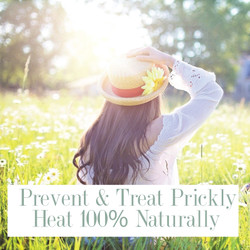Summer can be a great time for your skin; dryness, acne and other skin conditions tend to improve; sunshine replenishes what has been lacking in winter and cell turnover increases.
On the other hand, frustratingly, issues like prickly heat can become an issue.
What Causes Prickly Heat Rash?
Prickly heat (otherwise known as miliaria rubra/heat rash) most often appears in areas of friction, from things like skin or clothing. This means you often find prickly heat in places like the armpits, groin, neck and around the breasts where sweat can't evaporate easily and skin debris rubs into the pores and blocks them. [1]
High humidity and synthetic clothing have a similar effect, preventing the free-flow of sweat and its cooling evaporation from the skin.
This causes an uncomfortable prickling sensation on the skin along with an inflamed, irritated rash.
Although mostly entirely water, sweat is slightly salty and acidic, so if it can't evaporate easily, it will irritate the skin. This moist, warm environment becomes the perfect breeding ground for bacteria that naturally inhibits the skin, disrupting the balance and causing symptoms such as inflammation, infection and discomfort.
It has been found that prickly heat sufferers have about 3 times as much staphylococcus (a type of bacteria) present on their skin as those who aren’t suffering from the condition. Bacteria can be tackled with an anti antimicrobial agent[2] like aloe vera, which is found in our Repair Lotion - a great solution for skin that needs soothing! Repair Lotion also contains calming chickweed to ease itching and anti-inflammatory chamomile - just what the doctor ordered!
However, it's important to remember that bacteria is a consequence of sweat gland blockage, not the cause.
Who?
Anyone is at risk of experiencing this inconvenient rash under the right - or more suitably, wrong - conditions. Babies and children are particularly prone because their sweat glands aren’t fully matured and are vulnerable to blockages.
But, it is important to know that prickly heat rash can be prevented, so don’t feel you have to confine yourself inside! You can get out and enjoy the weather if you’re armed with a little bit of knowledge and some key products...
How to get rid of prickly heat
If you do find yourself with prickly heat, don’t panic, it should go away within a few days, but do try to keep cool whilst the rash calms down.
Taking a cool shower serves 3 purposes: it cools down the skin, removes sweat and bacteria and helps to unblock any clogged up sweat pores.
To wash, use organic skincare only - it will be free from irritating, synthetic sulphate detergents (which can also block pores) and if you choose one rich in rich in soothing and antibacterial aloe vera and essential oils like lavender, which can help calm the irritation and sooth inflammation, the rash should clear up quicker.
All of our body washes contain aloe, but for prickly heat, we suggest our Lavender Body Wash which is also antibacterial.
How To Prevent Prickly Heat

Rather than prickly heat treatment, the real is aim is prickly heat prevention. The goal is to keep your skin clear from anything that might inhibit the function of your sweat glands, which will also keep bacteria at bay.
A weekly body scrub with a gentle organic exfoliator is a great preventative meaure. This will slough off the dead surface skin cells which can block up sweat glands and leave your skin smooth for summer.
Antiperspirant is of course, going to play a role in trapping sweat. But we need to sweat! It’s a healthy function of the skin. And don't worry about odour, sweat itself doesn't have a bad odour, it's the bacteria which breaks it down. A good organic deodorant, free from aluminium is worth considering.
Synthetic skincare & prickly heat
Conventional skin and sun care products are commonly based on heavy, synthetic ingredients like petrolatum, paraffin and mineral oils which can have a 'saran-wrap' effect on the skin, trapping sweat, heat and bacteria - the perfect conditions for prickly heat.
Of course, when it comes to summer, naturally, applying sunscreen becomes part of many people's daily routine. But, if your sunscreen doesn't claim to be totally natural and based entirely on minerals like zinc oxide or titanium dioxide, then you can be sure it contains a cocktail of synthetic chemical ingredients.
Some of these ingredients have been shown to have safety issues and also be the cause of skin irritation
But don’t drop it altogether; it plays an important role in our health.
The saran-wrap effect of synthetic ingredients is heightened even more with “waterproof” sunscreens. Yes, they’re designed to keep water out, but they also keep sweat in.
The term “waterproof” is also quite misleading - no sunscreen is waterproof, because most likely, you’ll have to reapply after getting out of the water and after toweling off.
But all is not lost!
What is the perfect prickly heat sunscreen?
Choose sun protection with organic, plant-based ingredients. Not only can you forgo synthetic ingredients, but you can also choose a formulation that works with the natural chemistry of your skin, allowing it to breathe and be nourished at the same time.
To ensure you’re buying a genuinely organic formulation, choose a sunscreen that has been certified by an independent body, like the Soil Association/COSMOS. Their standards are some of the most rigorous in the world, so you can be confident you’re purchasing the most natural products when you find their logo on the packaging.
So if you do suffer from prickly heat, switch to an organic sunscreen and see the results for yourself.
When prickly heat isn’t prickly heat
Sometimes the reaction people believe is prickly heat isn’t actually the condition at all.
Dermatologist, Dr. Stefanie Williams says:
“it's worth noting that many people think they're suffering with heat rash when in fact they are reacting to sun cream.”
Skin allergy reactions are often confused for prickly heat because they’re so similar in appearance. What you might be experiencing is an allergic reaction to something you’re putting on your skin, which also could be sunscreen.
Many ingredients in synthetic sunscreen (and other conventional products) are scrutinized for their safety and known to cause other kinds of skin reactions. When certain chemicals are exposed to UV light or heat, they become unstable and breakdown and can become toxic as they sit on your skin.
But the solution is the same – cut the chemicals and switch to organic!
Organic, plant based ingredients are robust enough to withstand what nature throws at them and continue to do so on your skin. Our Natural Sun Screen is the perfect choice, using the power of nature to protect your skin, whether it’s from prickly heat or sunburn, without clogging your pores and allowing your skin to sweat naturally as it should!
Odylique provides a wide range of organic skincare perfect for preventing prickly heat and to soothe already irritated skin.
If you'd like any more advice on prickly heat and skincare, please do email us –info@odylique.co.uk, add your question as a comment below, or call us on (617) 500-8271– we're here to help!
References
[1] Champion RH. Disorders of sweat glands. Champion RH, Burton JL, Burns DA, Breathnach SM, eds. Textbook of Dermatology. 6th ed. Malden, Mass: Blackwell Scientific Publications; 1998. 1997-9.
[2] Holzle E, Kligman AM. The pathogenesis of miliaria rubra. Role of the resident microflora. Br J Dermatol. 1978 Aug. 99(2):117-37. [Medline].

